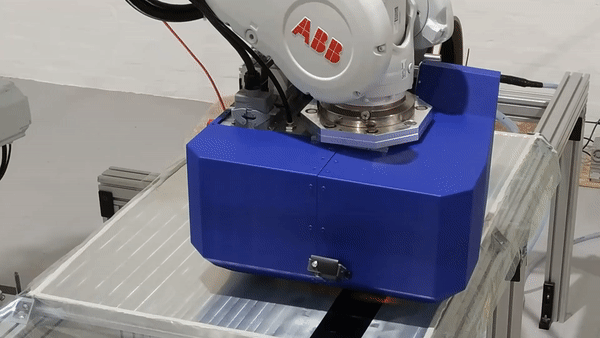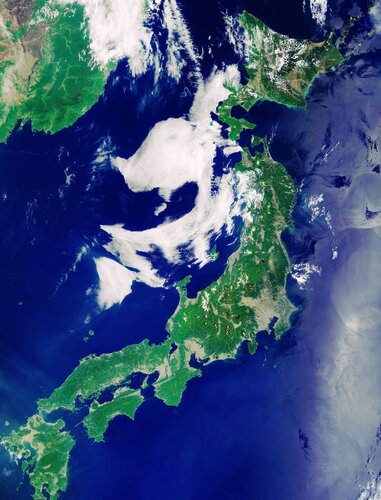
Copernical Team
Why does the Moon look close some nights and far away on other nights?
 Some nights the Moon seems really close and bigger than usual.
One summer evening when I was a child, I remember being mystified and then startled at a huge round shape slowly creeping up behind my friend Nancy's house, which sat on a hill on the other side of our village.
At some point I suddenly realized it was the Moon, and I ran yelling through the garden to tell my dad and get h
Some nights the Moon seems really close and bigger than usual.
One summer evening when I was a child, I remember being mystified and then startled at a huge round shape slowly creeping up behind my friend Nancy's house, which sat on a hill on the other side of our village.
At some point I suddenly realized it was the Moon, and I ran yelling through the garden to tell my dad and get h A mathematical tool to help understand fractal structure of quark-gluon plasma
 Quark-gluon plasma (QGP) is a state of matter existing at extremely temperatures and densities, such as those that occur in collisions of hadrons (protons, neutrons and mesons). Under so-called "normal" conditions, quarks and gluons are always confined in the structures that constitute hadrons, but when hadrons are accelerated to relativistic velocities and made to collide with each other, as th
Quark-gluon plasma (QGP) is a state of matter existing at extremely temperatures and densities, such as those that occur in collisions of hadrons (protons, neutrons and mesons). Under so-called "normal" conditions, quarks and gluons are always confined in the structures that constitute hadrons, but when hadrons are accelerated to relativistic velocities and made to collide with each other, as th SCOUT and LEOcloud collaborate on next gen space domain awareness services
 SCOUT Inc., a company developing next-generation space safety of flight and autonomous proximity operations services, and LEOcloud Inc., a company offering a scalable space-based, multi-cloud Infrastructure as a Services (IaaS) announced they have signed a Letter of Intent (LOI) to work jointly to enhance space operations safety.
The collaboration is focused on integrating SCOUT's Space Do
SCOUT Inc., a company developing next-generation space safety of flight and autonomous proximity operations services, and LEOcloud Inc., a company offering a scalable space-based, multi-cloud Infrastructure as a Services (IaaS) announced they have signed a Letter of Intent (LOI) to work jointly to enhance space operations safety.
The collaboration is focused on integrating SCOUT's Space Do SmartSat buys EOS Space Systems to advance its CHORUS tactical satellite terminals
 The Adelaide-based SmartSat Co-operative Research Centre has brought in Canberra-based EOS Space Systems to advance its Project CHORUS tactical satellite terminal.
Now a core partner, EOS Space Systems will have priority to select and lead strategic research projects alongside leading universities and global corporations to assist in the development of breakthrough technologies in military
The Adelaide-based SmartSat Co-operative Research Centre has brought in Canberra-based EOS Space Systems to advance its Project CHORUS tactical satellite terminal.
Now a core partner, EOS Space Systems will have priority to select and lead strategic research projects alongside leading universities and global corporations to assist in the development of breakthrough technologies in military Servicing support for Airmen assigned to Space Force fully operational
 The Air Force Materiel Command reached Full Operational Capability for its servicing major command support to Space Force-assigned Airmen, June 1, 2022.
As the servicing MAJCOM, AFMC is accomplishing the roles and responsibilities traditionally performed by a major command for the Airmen supporting the Space Force. These major command functions include, but are not limited to, providing po
The Air Force Materiel Command reached Full Operational Capability for its servicing major command support to Space Force-assigned Airmen, June 1, 2022.
As the servicing MAJCOM, AFMC is accomplishing the roles and responsibilities traditionally performed by a major command for the Airmen supporting the Space Force. These major command functions include, but are not limited to, providing po Maine looks to grow space economy, for students, research and business
 Maine leaders have long been searching for ways to keep more of high school and college graduates from leaving the state. But lobstering and forestry, two stalwarts of the Maine economy, aren't what they used to be.
Enter the new space economy.
"There's something sexy about space," Terry Shehata, executive director of the Maine Space Grant Consortium, a NASA-funded nonprofit, tol
Maine leaders have long been searching for ways to keep more of high school and college graduates from leaving the state. But lobstering and forestry, two stalwarts of the Maine economy, aren't what they used to be.
Enter the new space economy.
"There's something sexy about space," Terry Shehata, executive director of the Maine Space Grant Consortium, a NASA-funded nonprofit, tol NASA to launch 3 rockets from private Australian space port

NASA will launch a research rocket from remote northern Australia this month in the agency's first blast off from a commercial space port outside the United States.
Three suborbital sounding rockets will be launched from the Arnhem Space Center on Indigenous-owned land near the mining town of Nhulunbuy in the Northern Territory on June 26, July 4 and 12, said NASA and the launch pad's owner, Equatorial Launch Australia.
Tailor-made composites for tougher space structures

An ESA-led project constructed a test cylinder using a novel method of laying down carbon fibre, then tested it to buckling point within a crushing machine that subjected it to the equivalent of 10 tons of force. The cylinder met its predicted specifications perfectly, outperforming a traditionally-made equivalent using the same constituent materials. The company involved, iCOMAT in the UK, has now been shortlisted for the 2022 JEC World Composites Innovation Award – recognised as one of the year’s global top three main innovations in the field of aerospace composites.
Space-enabled 5G links Japan and Europe

Engineers have connected Japan and Europe via space-enabled next-generation 5G telecommunication links. It is the first time that such an intercontinental connection has been established between Europe and Japan.
Mars sleeps with one eye open

This scarred and colourful (by martian standards!) landscape shows part of Aonia Terra, an upland region in the southern highlands of Mars. The image was taken by ESA’s Mars Express on 25 April 2022.

